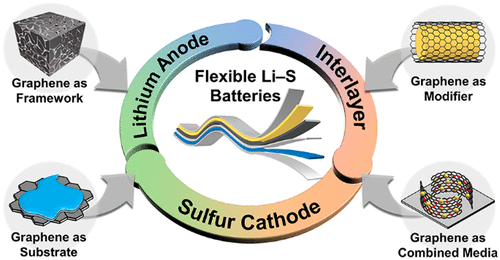Our official English website, www.x-mol.net, welcomes your
feedback! (Note: you will need to create a separate account there.)
Graphene-Based Materials for Flexible Lithium–Sulfur Batteries
ACS Nano ( IF 15.8 ) Pub Date : 2021-09-13 , DOI: 10.1021/acsnano.1c03183 Tian Yang 1 , Jun Xia 1 , Zhihong Piao 2 , Lin Yang 1 , Shichao Zhang 1 , Yalan Xing 1 , Guangmin Zhou 2
ACS Nano ( IF 15.8 ) Pub Date : 2021-09-13 , DOI: 10.1021/acsnano.1c03183 Tian Yang 1 , Jun Xia 1 , Zhihong Piao 2 , Lin Yang 1 , Shichao Zhang 1 , Yalan Xing 1 , Guangmin Zhou 2
Affiliation

|
The increasing demand for wearable electronic devices necessitates flexible batteries with high stability and desirable energy density. Flexible lithium–sulfur batteries (FLSBs) have been increasingly studied due to their high theoretical energy density through the multielectron chemistry of low-cost sulfur. However, the implementation of FLSBs is challenged by several obstacles, including their low practical energy density, short life, and poor flexibility. Various graphene-based materials have been applied to address these issues. Graphene, with good conductivity and flexibility, exhibits synergistic effects with other active/catalytic/flexible materials to form multifunctional graphene-based materials, which play a pivotal role in FLSBs. This review summarizes the recent progress of graphene-based materials that have been used as various FLSB components, including cathodes, interlayers, and anodes. Particular attention is focused on the precise nanostructures, graphene efficacy, interfacial effects, and battery layout for realizing FLSBs with good flexibility, energy density, and cycling stability.
中文翻译:

用于柔性锂硫电池的石墨烯基材料
对可穿戴电子设备日益增长的需求需要具有高稳定性和理想能量密度的柔性电池。柔性锂硫电池(FLSB)由于其通过低成本硫的多电子化学具有高理论能量密度而得到越来越多的研究。然而,FLSBs 的实施受到几个障碍的挑战,包括其实际能量密度低、寿命短和灵活性差。各种基于石墨烯的材料已被应用于解决这些问题。石墨烯具有良好的导电性和柔韧性,与其他活性/催化/柔性材料表现出协同作用,形成多功能石墨烯基材料,在FLSBs中发挥着举足轻重的作用。这篇综述总结了石墨烯基材料的最新进展,这些材料已被用作各种 FLSB 组件,包括阴极、夹层和阳极。特别关注精确的纳米结构、石墨烯功效、界面效应和电池布局,以实现具有良好柔韧性、能量密度和循环稳定性的 FLSB。
更新日期:2021-09-28
中文翻译:

用于柔性锂硫电池的石墨烯基材料
对可穿戴电子设备日益增长的需求需要具有高稳定性和理想能量密度的柔性电池。柔性锂硫电池(FLSB)由于其通过低成本硫的多电子化学具有高理论能量密度而得到越来越多的研究。然而,FLSBs 的实施受到几个障碍的挑战,包括其实际能量密度低、寿命短和灵活性差。各种基于石墨烯的材料已被应用于解决这些问题。石墨烯具有良好的导电性和柔韧性,与其他活性/催化/柔性材料表现出协同作用,形成多功能石墨烯基材料,在FLSBs中发挥着举足轻重的作用。这篇综述总结了石墨烯基材料的最新进展,这些材料已被用作各种 FLSB 组件,包括阴极、夹层和阳极。特别关注精确的纳米结构、石墨烯功效、界面效应和电池布局,以实现具有良好柔韧性、能量密度和循环稳定性的 FLSB。











































 京公网安备 11010802027423号
京公网安备 11010802027423号